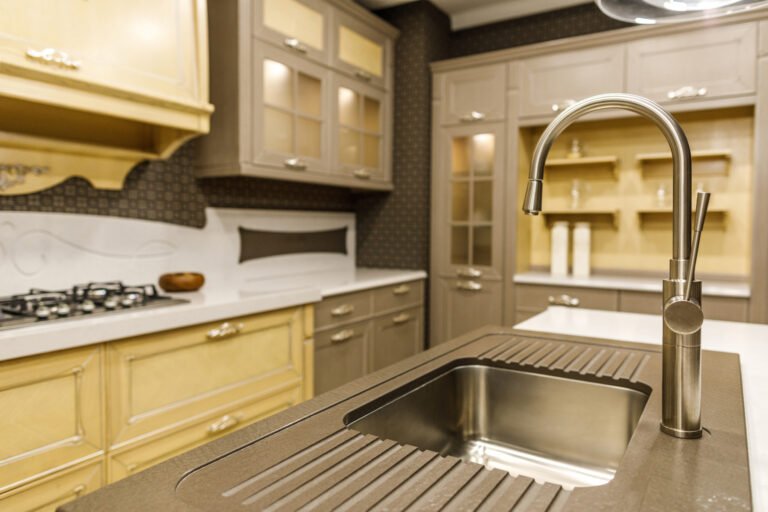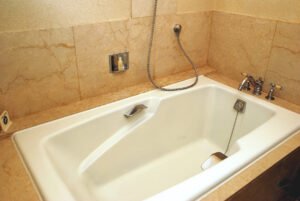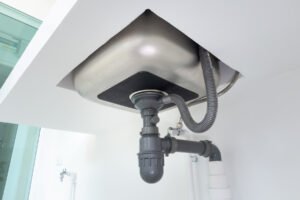Uplifting your kitchen decor is fun but looks pricey when the existing appliances and sinks don’t blend with the new style. Since kitchen sinks come in a limited palette of colors and finishes, it’s even more challenging to integrate them with different home interior styles.
Moreover, sinks are expensive. So, it’s nearly impossible to install a new sink on a tight budget. So, how do you spruce up your sink? Can you paint it? If yes, how do you do it efficiently? Find all the answers in this guide.
You can paint a kitchen sink, but the workability and adhesion of the paint vary depending on the sink material. While plastic, steel, or aluminum sinks are much easier to paint, painting a stone or porcelain kitchen sink requires the right tools, practice, and prep work.
Which Kitchen Sinks Can You Paint Efficiently?
Kitchen sinks are made of various plastics, stones, steel, and even earth materials. Though some look even more furnished with painting, some materials resist paint and don’t adhere well to it. So, let’s find out which types of kitchen sink you can paint.
1. Can You Paint Your Stainless Steel Sink?
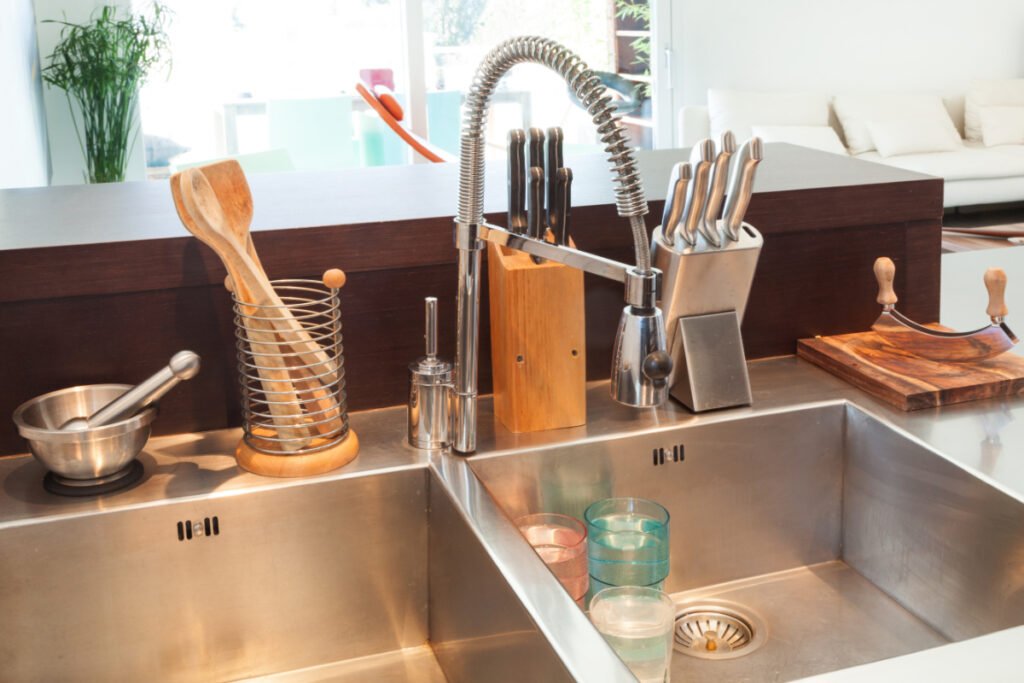
You can paint a stainless steel sink, but since it has a polished surface, you need to sand and scuff it for the paint to adhere well. But if your kitchen sink has chromium or rust-free finish, you need to use a high-quality, heavy-duty epoxy paint as any other paints would soon wash off.
However, if your kitchen sink has a mirror or satin finish, you must first clean it, sand it, use a metal-etching primer, and paint the steel with a good-quality brush. If your brush doesn’t fit well on the sink’s curves, use epoxy paint sprayers or aerosol cans to give you a smooth finish.
Alternatively, if your steel sink has brushed or matte finishes, you can skip the priming process and begin painting right away. Still, seal the surface with an aliphatic acrylic polyurethane solution for a durable paint stain.
Since a stainless steel sink is comparatively sleeky and soapy, you can slightly dilute the paint with water to avoid a grainy texture on the sink surface.
2. Can You Paint Aluminum Sinks?
Aluminum sinks are comparatively easy to paint since they have a rough, semi-gloss finish that adheres to the paint and makes it last longer. Since aluminum sinks have a cuboidal, box-like structure, you can easily paint them yourself using a flat-headed paintbrush.
However, since aluminum is a brittle material, you first need to seal all the cracks on the sink surface with a good-quality epoxy premix solution and allow it to cure.
Afterward, clean the sink with dish soap, warm water, and vinegar, scuff lightly with high-grit sandpaper or steel wool and finish it with any aluminum paint like Rustoleum’s Industrial Enamel.
Once painted, it’s advisable to polish the aluminum sink with baby oil and towels for a smoother, even finish.
3. Can You Paint an Earthen Kitchen Sink?
Yes, you can paint earthen sinks, but you might have difficulty maintaining its finish as the material absorbs most of the paint applied. Hence, use a good-quality waterproof sealer and a primer on the sink surface and finish it with water-based latex or acrylic paint.
After you finish painting and drying the sink, glaze and seal every painted part with a latex glazing compound to help the paint last longer.
4. Can You Paint a Cast Iron Sink?
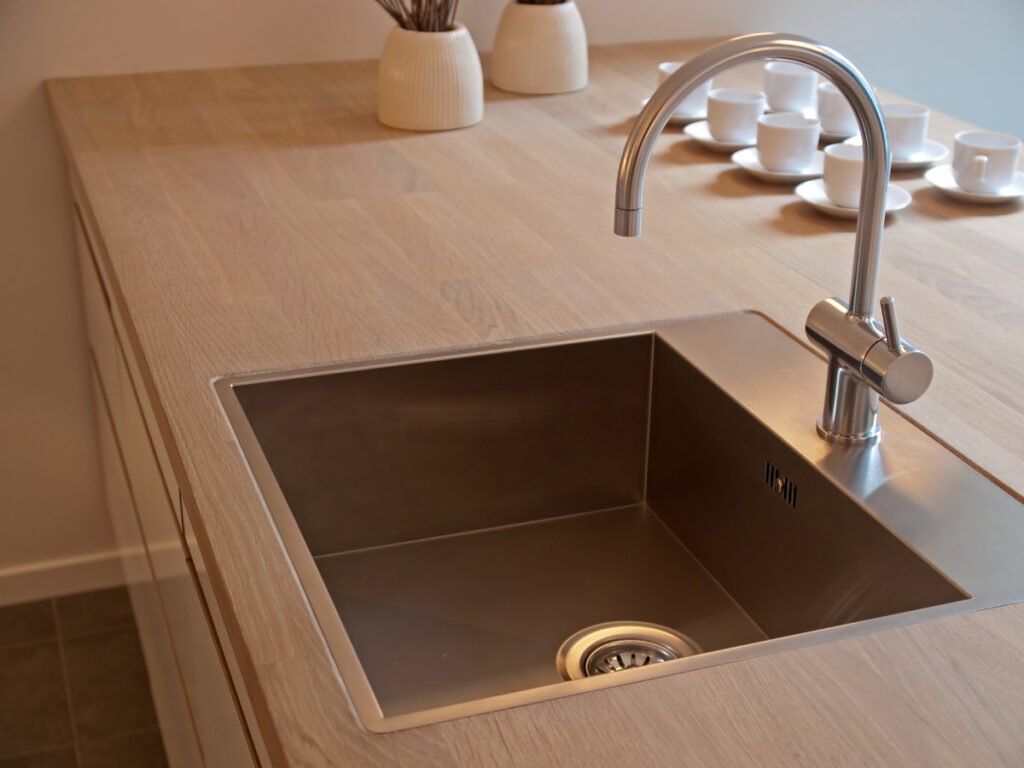
Painting cast iron sinks is relatively easy. You can use any oil-based acrylic or alkyd paints that adhere well and prevent rusting. To create a good foundation for paint, first remove the old paint and rust with a wired brush or an electric drill, sand it, and use a good-quality primer.
After that, you can paint it in any color of your choice. Lastly, add an acrylic topcoat that prevents your sink paint from weathering away, or spray a good-quality enamel sealer for a shiny, modern kitchen sink.
You should use oil paint for the first paint coat on your cast iron sink, but you can complete the remaining coats with water-based urethane paint for a classic, industrial finish. Plus, it will also save up on costs.
5. Can You Paint the Granite Kitchen Sink?
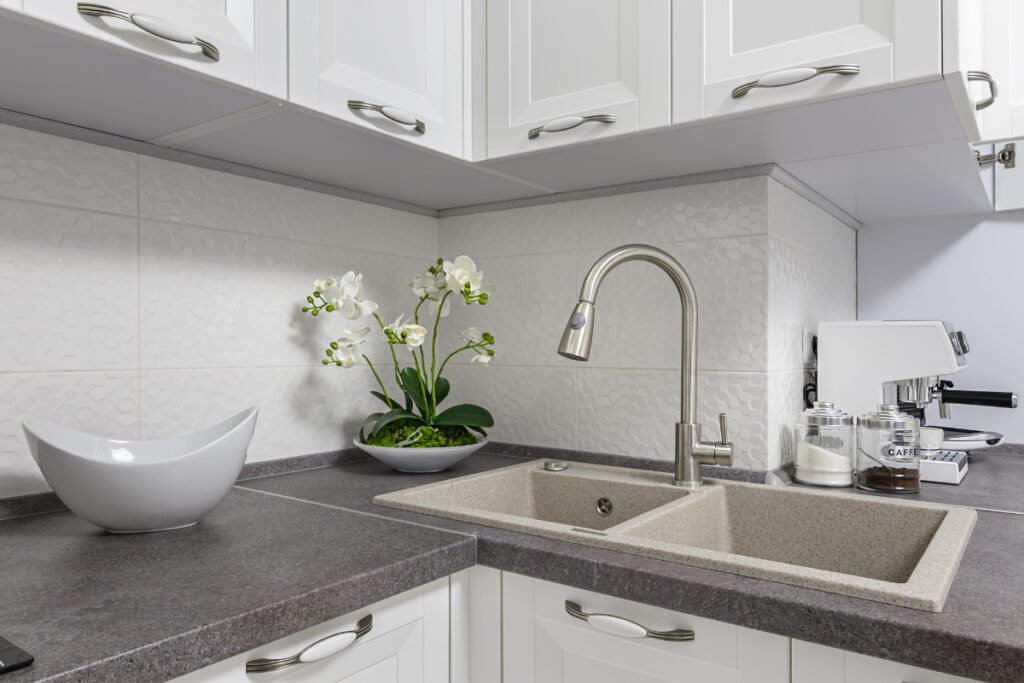
Yes, you can paint a granite kitchen sink, provided that the stone has no chips, cracks, or other deformities. If present, you’ll first need to seal the cracks with an epoxy resin, spray an acrylic primer to roughen the foundation, and then paint the sink with epoxy paint.
Generally, a natural granite sink looks furnished, textured, and farmhouse style with 2-3 coats of epoxy paint, but you can also spray a chemical sealer to prevent it from fading quickly.
And, if you have a composite granite kitchen sink, there’s no need for a sealer, but clean it with a good-quality cleaner, bleach, and water to maintain the paint’s shine.
If you have hard water from your tap, you might see a slight discoloration in the sink paint. Hence, always use dark paints when painting your granite sink.
6. Can You Paint Kitchen Sinks Made of Porcelain?
You can paint a porcelain sink, but since it has a smooth, sleek finish, you will need to do some prep work. Start by cleaning the porcelain sink with trisodium phosphate, then spray a bonding agent to create a coarse surface. Next, sand it a little, apply a primer, and start painting with urethane paint.
Moreover, since porcelain is a brittle material, it is advisable to paint it with small, even brush strokes rather than a pressurized jet of spray paint.
Alternatively, you can even powder coat your porcelain sink with fluoropolymer powder paint, but since it will wear down much faster due to water, you’ll need to repaint it frequently.
After painting, it’s advisable to sand porcelain sinks with 100-grit sandpaper to prevent rough patches and uneven brush strokes on the sink surface.
7. Can You Paint Over Fire-Clay Sinks?
Fire-clay sinks are tricky to paint as they stain quickly. But you can still ensure a smooth paint finish by spraying a suitable bonding agent and rubbing it with steel wool. Then, after sanding, you can paint it with any self-leveling epoxy paint or epoxy spray for an even sink finish.
It’s always good to repair the cracks and dents in your fire-clay sinks using a good quality filler material before you start painting them.
8. Can You Paint Your Ceramic Sinks?
Yes, ceramic sinks are easily paintable and have a rigid surface that helps the paint adhere. Plus, since they have a slightly coarse surface, you can use shinier acrylic latex paint or two-part epoxy to create a rustic look for your kitchen or bathroom.
Moreover, ceramic sinks don’t require much prep work before starting the painting. Just brush the sink with a soft-bristled brush, clean it with any non-abrasive cleaner, sand it lightly, and you are good to go.
Spray a surface repair epoxy onto your sink; if it chips and cracks after painting. You can even match the color of your epoxy spray and sink paint to look more cohesive.
9. Can You Paint Kitchen Sinks Made of Plastic?
Plastic sinks are difficult to paint since they are highly glossy and have a smooth surface. But you can still paint them by scrubbing their surface with steel wool and using 2-3 coats of tub/bathroom tile spray paint.
Always double-check for any dents on your plastic sink before painting, as it will create an uneven surface for painting and result in a thin coat in places.
Which Type Of Kitchen Sinks Cannot Be Painted?
- Damaged, Dented, or Broken Sinks: If your kitchen sink has chips, dents, and cracks in places, it’s better to replace them rather than painting it.
- Copper Sink: Copper patina does not adhere to paint, and even if forcefully painted with heavy-duty epoxy, it will tear down in a couple of days with continuous use.
- Quartz Sink: Quartz is an expensive and textured sink material. Hence, paint will not fit evenly onto its surface, resulting in a bubble-like look.
Which Is The Best Paint For Your Kitchen Sinks?
The best types of paint for kitchen sinks are waterproof metallic, epoxy, and urethane paints. On the other hand, you cannot use standard emulsion, distemper, or oil-based paint to paint your sink as they will wear down with moisture and tear apart easily.
1. Urethane Paint: Urethane paints are a top choice for fire clay, porcelain, and metal sinks and guarantee a smooth, even surface finish with quick curing. Moreover, they are really inexpensive yet durable to withstand all your sink’s excessive scrubbing and moisture content.
However, they may have uniform flow issues with a paint sprayer, so it’s better to use them with a soft paintbrush or roller.
2. Metallic paint: Metallic paints are premium quality paint used for metal, aluminum, or ceramic sinks and offer a shiny, reflective surface that goes well with modern kitchen designs. But since they are oil-based, they will make it tough to repair any chips and scratches after painting the sink and will need to be repainted.
3. Acrylic paint: Acrylic paints add a nice, glossy finish to any matte sink material like ceramic, fire clay, earth, or porcelain. However, since they do not repel water to a greater extent, you will need to finish them off with a sealer or bonding agent to last longer.
4. Epoxy paint: Epoxy paints are the right tap to paint most sink materials like steel, ceramic, earthen, and even porcelain, and add a protective film that protects the sink from further damage.
However, epoxy paints require meticulous cleaning beforehand and will not adhere well if there is grease, oil, or dirt on your sink. Furthermore, these paints take a long time to dry and may be difficult to remove if you decide to change the color later.
What Is The Best Spray Paint For Kitchen Sinks?
Standard epoxy-acrylic sprays, enamel sprays, appliance sprays, and epoxy-enamel spray paints are the best to furnish your kitchen sinks. It’s best to splash some rust-preventive spray before using the sprays to create a more durable surface for the paint.
On the other hand, 2k, lacquer, or chalkboard spray paints do not form an even coat on the sink surface and might peel off on contact with water.
Can You Paint Your Old Kitchen Sink?
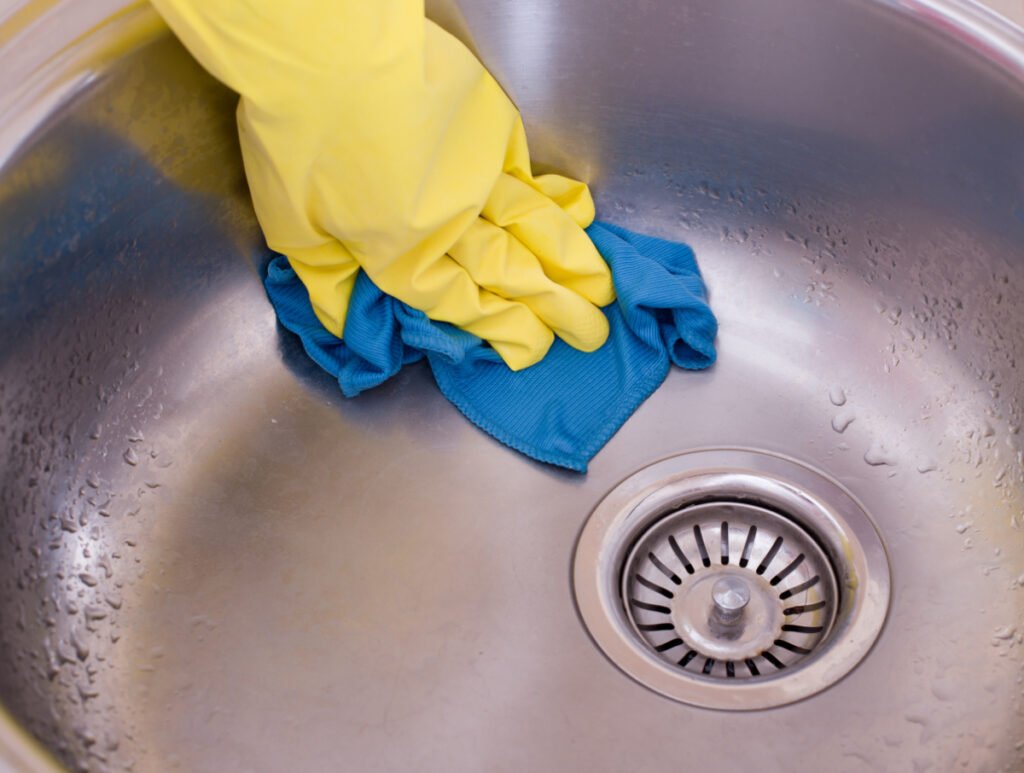
Yes, you can undoubtedly paint any old kitchen sink, provided that it is not damaged, rusted beyond repair, chipped, cracked, or broken. Then, once you seal all the cracks and chips using a filler and bonding agent, refurbish it as guided below:
- Cleaning: Clean the sink thoroughly using a rust cleaner and brush off all the particles using a hard-bristle paintbrush. Pour a good-quality cleaner down your sink, and give it a good wipe with a soft rag.
- Sealing: Use a paper towel and scrub your sink surface with a bonding agent or sealer to fill in all the hair-line gaps that might be visible after painting.
- Priming: Apply a heavy-duty epoxy primer to your sink surface and sand it a little to create a coarse texture.
- Painting: Lastly, paint it with epoxy paint and apply a topcoat to improve its water resistance.
Tips For Painting Your Kitchen Sinks:
- Any sink paint can cause extreme nausea or drowsiness if inhaled for longer. Hence, always switch on the ceiling fans and open your windows while painting the sink.
- Always spray an aliphatic acrylic polyurethane sealer on your painted sink to help it resist water and heat. You can also pick glossy or matte sealer finishes to match your kitchen decor.
- Liquid paints tend to accumulate at the corners and low-lying areas of your kitchen sink. So, always rub these areas with 100-grit sandpaper for a uniform finish.
- Never forget to spray a rust convertor or primer before you start painting the sink for a more durable surface.
- Never paint the sink in a single, thick coat, and always prefer multiple, thin paint coats.
- Don’t scrub too hard with sandpaper; it might result in permanent scratches that will still be visible after painting.
Does Painting Kitchen Sink Cause Any Plumbing Issues?
Painting the kitchen or bathroom sink does not cause any plumbing issues if you let the paint cure and dry properly. However, you should seal all your plumbing connections and cover your drain so that the paint does not fall into it and result in a clogged pipe.
How Do You Seal A Kitchen Sink Before Painting?
Push a sink strainer through the drain hole of your sink and apply a pipe-joint compound to its edges to prevent water and any fallen paint from entering your drain. Additionally, slide a washer onto the ends of the filter to create a better seal at the edges.
Do You Need A Primer For Spray Paints?
Spray paint does not need a primer to achieve a smooth finish, but it does require one for more durability and water resistance. Therefore, applying a primer is always good, especially for water-based spray paints that might weather off with prolonged sink use.
How Do I Paint My Kitchen Sink White?
Painting a kitchen sink white is relatively easy. All you need to do is wipe off all the grease and grime with baking soda and water, give it a thorough wash with acetone, sand it a little, and then you can paint it with any white epoxy paint. Rustoleum’s ‘White Epoxy’ is an excellent choice for this purpose.
Can You Powder Coat A Kitchen Sink?
Yes, you can powder coat a kitchen sink, especially metal, steel, and aluminum sinks. Powder Coating will give you an enhanced surface finish, and you will also be more wear-resistant and durable. The only downside is the tedious prep work before painting and its high costs compared to paint.
Can You Paint A Sink Top?
Yes, you can paint your sink top to match your kitchen countertop or bathroom shelves, but you’ll need to ensure that you use only high-quality, heavy-duty epoxy paints. Also, it’s advisable to seal it with a polyacrylic sealer for better water resistance.
Painting your kitchen sinks is a smart, inexpensive way to uplift your kitchen decor and make it look well-knit and cohesive. First, you need to prep the surface using a primer and binding agent and lightly sand it. Then, you can paint it with any color of your choice!
This guide will provide you with all the tips and tricks you need while painting your kitchen sink. But if the sink is chipped or weathered, then it’s best to replace it in a way that doesn’t put a load on lower cabinets. You can find out how much weight your cabinets can hold in my next guide.

